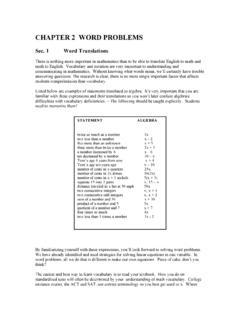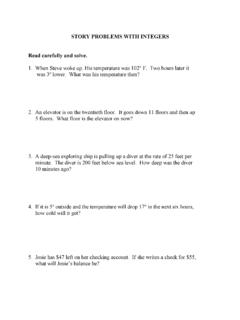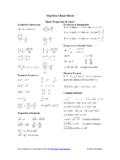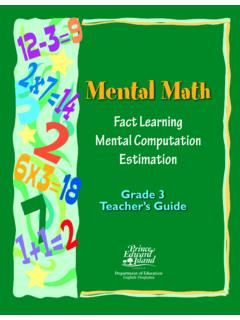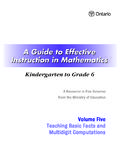Transcription of Strategies - Hanlon Math
1 Bill Hanlon Strategies for Learning the math Facts Strategies for Learning math Facts Page 2 of 6 The more sophisticated mental operations in mathematics of analysis, synthesis, and evaluation are impossible without rapid and accurate recall of specific knowledge. Learning the arithmetic facts in the first four grades can be pretty hard work for some students. Learning these facts through only rote memorization will make it more difficult than it needs to be for students. Teaching students Strategies to help them learn and memorize the arithmetic facts will make life easier on the kids, their parents, and especially on you.
2 Before any memorization takes place, the concept for each operation should be explained fully so the students are comfortable in their understanding of the operation. Addition Thinking Strategies for Learning the Addition Facts There are 100 basic arithmetic facts, zero through nine. That s a bunch. But if we use more effective Strategies to help students learn, then memorizing these facts will become easier for the students. These Strategies have been listed in the order we suggest teachers use to teach their own students. 1. Adding zero: Students can quickly grasp the rule for adding zero; the sum is always the other number. 8 + 0 = 8, 0 + 4 = 4 2. Counting on by 1 or 2: Students can find sums like 5 + 1 or 6 + 2 by simply counting on. This thinking strategy allows students to check off 18 of the addition facts. That leaves 63 facts to be learned. 3.
3 Sums to 5: Students can learn combinations to 5, such as 3 + 2 or 4 + 1. Sums to 5 is redundant. 4. Sums to 10: Students can learn combinations to 10, such as 6 + 4 or 8 + 2. More facts can be crossed off the list of 100 and we are down to 56 facts to learn. 5. Doubles: For whatever reason, students seem to be able to remember the sums of doubles. That might be a consequence of skip counting in earlier grades. The consequence of knowing doubles is another 6 facts can be checked off our list. That leaves 50 facts to learn, we re halfway home. 6. Adding 10 s: Students can quickly see the pattern develop when adding tens, the units digit stays the same. Strategies for Learning math Facts Page 3 of 6 7. Doubles plus one: This strategy overlaps the other Strategies of doubles and counting on by one.
4 While more sophisticated, students should be taught to use this strategy when the addends are consecutive numbers. For instance, 7 + 8 becomes 7 + 7 + 1. Another example, 8 + 9 becomes 8 + 8 + s seven more off the list. 8. Doubles plus two: This method works when the addends differ by two. When this occurs it is possible to subtract 1 from one addend and add one to the other addend. This results in a doubles fact that has already been memorized, 7 + 5 becomes 6 + 6. Another example, 6 + 8 becomes 7 + 7. Some people call the Doubles Plus 2 strategy Sharing Doubles and attack the problem differently. Using the Doubles plus 2 strategy, 6 + 8 becomes 6 + 6 + 2. 7 + 5 becomes 5 + 5 + 2. We now have 31 facts left to learn. 9. Nines: It should be pointed out to students that when adding nine, the ones digit in the sum is always one less than the number added to 9.
5 For example 7 + 9 = 16, the 6 is one less than 7. Another example, 5 + 9 = 14. 45 facts to go. 10. Commutativity: By changing the order, 3 + 4 to 4 + 3, it should be pointed out that s an additional 21 facts the students now know. That leaves 10 facts to learn. But it s really five because the commutative property can be used on those 10. There are other Strategies to learning the addition facts. Some teachers might use Combinations to 5 as a strategy. Rather than using Sharing doubles, some teachers might use Doubles plus 2 . That doesn t matter. What does matter is you make sure students understand the meaning of addition and you develop Strategies to help them memorize the facts. It is expected that students respond automatically when asked a basic addition fact . Subtraction Thinking Strategies for Learning the Subtraction Facts 1. fact families: This strategy is the most commonly used and works when students understand the relationship between addition and subtraction.
6 When students see 6 2 and think 2 + ? =6. However, if this strategy is used with the following Strategies , students will find greater success in a shorter period of time. 2. Counting backwards: This method is similar to Counting on used in addition. It isn t quite as easy. Some might think if you can count forward, then you can automatically count backward. This is not true try saying the alphabet backwards. Students should only be allowed to count back at most three. 3. Zeros: The pattern for subtracting zero is readily recognizable. 5 0 = 5 Strategies for Learning math Facts Page 4 of 6 4. Sames: This method is used when a number is subtracted from itself; this is another generalization that students can quickly identify.
7 7 7 = 0. 5. Recognizing Doubles: Recognizing the fact families associated with adding doubles. 6. Subtracting tens: This is a pattern that students can pick up on very quickly, seeing that the ones digit remains the same. 7. Subtracting from ten: Recognizing the fact families for Sums to 10. 8. Subtracting nines: Again, the pattern that develops for subtracting 9 can be easily identified by most students. They can quickly subtract 9 from a minuend by adding 1 to the ones digit in the minuend. 17 9 = 8, 16 9 = 7. 9. Subtracting numbers with consecutive ones digits: This pattern will always result in a difference of 9, 16 7 = 9, 13 4,= 9 15 6 = 9 all have ones digits that are consecutive and the result is always 9. 10. Subtracting numbers with consecutive even or consecutive odd ones digits: This pattern will always result in a difference of 8.
8 14 6 = 8, 13 5 = 8, 12 4 = 8. These Strategies clearly help students to subtract quickly. How you teach these Strategies , allowing the students see the patterns develop, will make students more comfortable using these shortcuts and get them off their fingers. Having said that, as with many of the concepts and skills in math , students need to compare and contrast problems to make them more recognizable to them. Without being able to identify the proper strategy by examining the problem, memorizing these Strategies may become more burdensome and cause greater confusion than just rote memorization. So while you might teach one strategy at a time, as you add to the number of Strategies students can use for a specific numbers, you will need to review previous Strategies and, this is important, combine Strategies on the same work sheets asking students to only identify the strategy they would use for each problem and why they are using it.
9 Being able to compare and contrast will lead to increased student understanding, comfort, and achievement using these For example, 16 9, students are subtracting 9, they add one to the units digit. 15 7, students are subtracting numbers with consecutive odd units digits, the difference is 8. 17 8, students are subtracting numbers with consecutive units digits, the difference is 9 Strategies for Learning math Facts Page 5 of 6 Multiplication Thinking Strategies for Learning the Multiplication Facts 1. Commutativity: As with learning the addition facts, order can be changed when learning the multiplication facts. Hence, rather than learning 100 facts, we really only have to learn 55 facts. 2. Multiplication by zero: Students can easily grasp that 0 times any number is zero.
10 3. Multiplication by one: Again, the generalization is easy for students to see that 1 times any number is the number. 4. Multiplication by two: Students should be taught that multiplying by two is the Doubling strategy used in addition. Using the first four Strategies , we have learned 27 more facts; only 28 remain to be learned. 5. Multiplication by five: Students can often be taught the fives by referring to the minute hand on a clock. 6. Squaring: As with the addition facts, students seem to learn square numbers faster than other facts. 7. Multiplication by ten: This pattern is very easy for students to see. 8. Multiplication by nine: Patterns emerge when multiplying by 9. One pattern is the sum of the digits in the product is always equal to 9. The other pattern is the ten s digit is always one less than the factor multiplied by 9. 9 6 = 54. Notice 5 + 4 = 9 and the 5 in the product is one less 6, the number being multiplied by 9.
